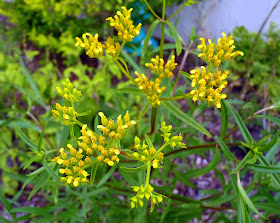Giant Swallowtail caterpillars are masters of defense. They use a variety of measures to protect themselves from predators, including living on very hostile host plants. The thorns on citrus plants are natural protection, and rue contains oils that can cause irritation. Of course, in our opinion, their best defense is their appearance. Looking like a shiny pile of bird poo makes you awfully unappetizing, don't you think?
 If that doesn't work (and I'm not sure why it wouldn't), Giant Swallowtail caterpillars also have an osmeterium, a set of little fleshy horns that they project when feeling threatened. The osmeterium contains a foul-smelling substance that basically says, "Not only do I look disgusting, I smell disgusting, too." It's easy to tell when you've irritated a Giant Swallowtail caterpillar by the stench that fills the air.
If that doesn't work (and I'm not sure why it wouldn't), Giant Swallowtail caterpillars also have an osmeterium, a set of little fleshy horns that they project when feeling threatened. The osmeterium contains a foul-smelling substance that basically says, "Not only do I look disgusting, I smell disgusting, too." It's easy to tell when you've irritated a Giant Swallowtail caterpillar by the stench that fills the air.When they're ready to pupate into chrysalis, the caterpillars "assume the position" by spinning their silken pads and suspending themselves with a thin thread across the middle. This fellow decided to do so on our garage door, so we had to move him before we could open the door without squishing him. (Kind of a waste of all those defensive caterpillar moves, huh?) The chrysalis looks similar to the caterpillar in coloring, but also has the dry look of a dead leaf, allowing them to continue to blend in well when they are most vulnerable.
From ugly caterpillar to one of the most beautiful of butterflies, Giant Swallowtails add so much pleasure to My Florida Backyard. We're thrilled to have discovered rue, the host plant that helps us support their entire life cycle!





















